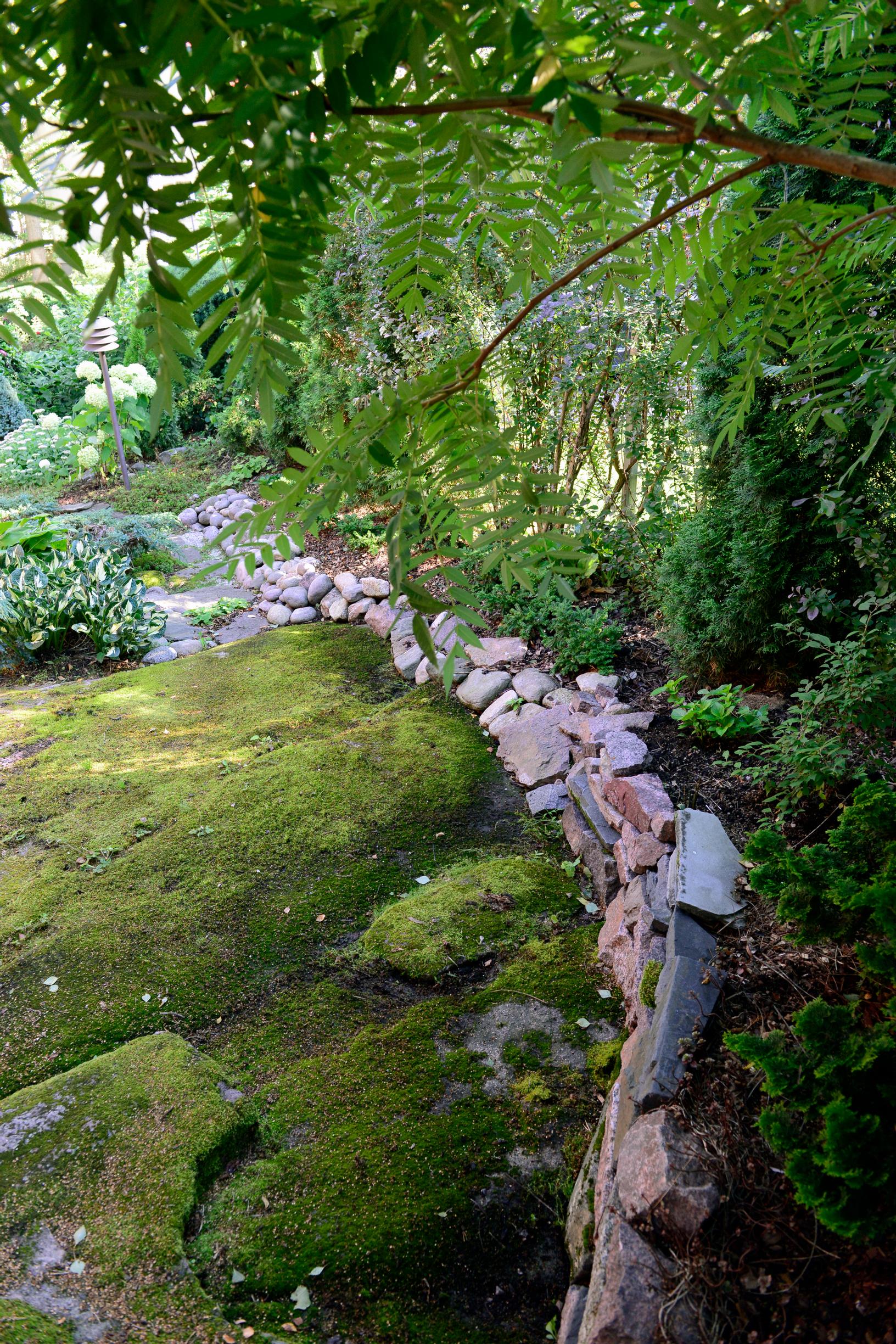
Don’t remove it—cherish it! Moss is a garden treasure: 16 scenes to inspire you
Moss is the easiest plant to care for in the garden—it thrives when you simply let it be. With nearly 900 species in Finland, hardy moss flourishes in a surprisingly wide range of habitats. Even after dry spells, moss often bounces back when the rains return.
Moss in the garden—ideas:
Decorating a stone wall
Stone and moss make a natural pair. While moss often grows on stones over time, you can encourage it to grow more quickly. Collect moss from nearby so the conditions in your garden are well suited for it. Note: In Finland, collecting moss requires the landowner’s permission. Crumble the moss finely and mix it with buttermilk. Brush this mixture onto the stones. You can also drizzle it into the gaps between paving stones.

In this garden at the forest’s edge, moss cascades over the top of the wall. Coral bells are planted in the pot.

A soft cascade
A garden ornament draws the eye to the edge of the rock, where a deep green moss cascade flows.

A smooth moss carpet
In this garden, moss has been nurtured for a long time. Any tufts of grass are weeded from the even moss carpet when they are still small, so the moss remains lush. Additionally, the area is raked with an old leaf rake, whose metallic, very flexible tines clean the moss without tearing it.


Green shapes
At this cottage yard, the beautiful moss-covered stones are as important as the plants. In spring, they stand out beautifully on the slope when the plants are still small. The moss dries to gray during dry summers but turns green again when it rains.



A sauna under a moss roof
The roof of this cottage sauna is so cleverly disguised with lichen and moss that it becomes part of the surrounding forest. The owner wanted the sauna to blend in with the rest of the yard of the summer cottage, which is full of stones, old trees, and lingonberry shrubs.

In this summer paradise, moss speckles the stones in an area where you can pop over from the log sauna to cool off.

A path sewn with moss
Moss looks naturally beautiful between the stepping stones in this garden. It’s best for the slabs or flagstones to be close together, as moss cannot withstand constant trampling.

By the water
Moss and water features go well together.This incredible garden has been in the making for almost 50 years. The waterfall is adorned with irises, ferns, and climbing plants like Dutchman’s pipe and hops.

In a Japanese style
If you’re seeking a Japanese atmosphere in your garden, moss is definitely your ally. In historical Japanese gardens, moss is one of the essential elements.


A tranquil potted planting
In a shady spot, you can plant perennial hostas, ferns, and hazelwort in a pot and cover the soil with moss. If you collect moss (with the landowner’s permission), don’t clear the whole area—leave some to regenerate. Moss can also be purchased from florists.

Or a mini landscape!
Every spring, the owner of this garden creates a miniature version of the rockery found in her garden.

Moss wall on the balcony
Garden therapist Pirjo Luokkala built a two-meter moss wall on her balcony to bring the forest and nature closer. When you close your eyes on the balcony, it feels like you step out of the city for a moment, as the scent of the forest surrounds you.

Moss: transplant or cultivate
- You can ‘plant’ moss in your garden using transplants collected with the landowner’s permission. Collect clumps from places with similar light and growth conditions to where they will be placed in your yard. The soil in the new spot should be free of weeds. Water the transplants diligently after planting. In the early stages, the water can be fortified with buttermilk to help the moss settle in.
- You can also grow moss. Shred clumps into a moist mass and spread it thinly over some newspapers. Place the cultivation in shade and keep it evenly moist. When the moss starts to grow, move the green mat to its permanent location.


